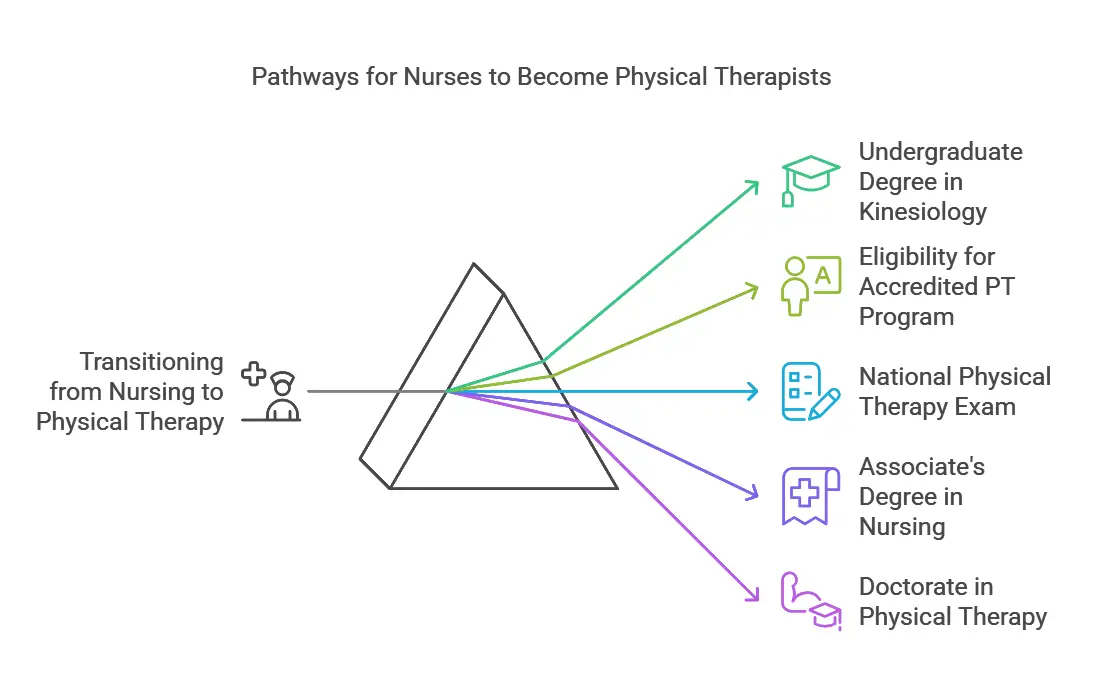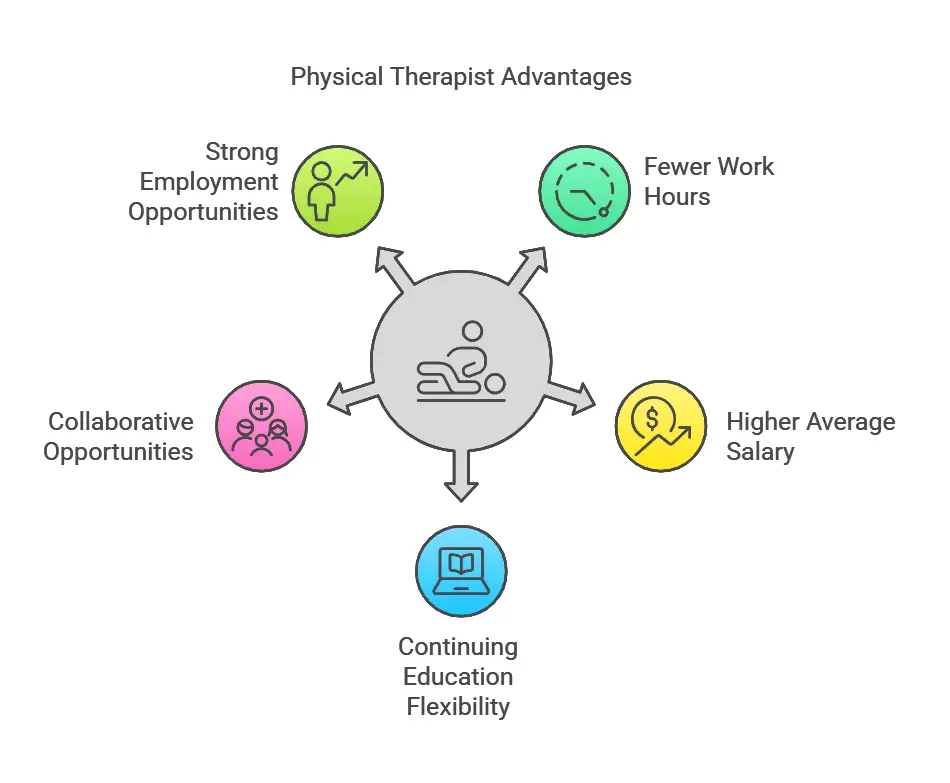Physical therapy is known as the profession that nurses can do because they have to take care of patients and provide treatment. There are various misconceptions about whether nurses can become physical therapists.
In this blog post, I will discuss the differences between a nurse and a physical therapist, becoming a physical therapist with just an associate’s degree in nursing, and some benefits to becoming or why you might become a physical therapist.
With What Qualifications Can a nurse become a physical therapist?
That is the question that many nurses ask themselves when they are deciding what to do with their careers. Having a degree in nursing doesn’t automatically qualify you for a physical therapist degree, but it opens up more possibilities than if you only had your nursing degree. There are two ways to become a PT:
- Getting an undergraduate degree in kinesiology and then applying to PT school or taking the NATP exam.
- Becoming eligible to take classes at any accredited PT program.
- In addition, you will need to take the National Physical Therapy Exam within 18 months of completing your degree in nursing and pass with a score of 410 or above on the exam.
- RNs can prepare for a career in physical therapy by earning their Associate’s Degree in Nursing and completing the prerequisites needed to become one.
- Physical therapists have to earn a doctorate, which takes 4-6 more years of study than an RN’s Associate’s or Bachelor’s degrees combined.
- To transition into this profession from being an RN requires passing state licensure exams and other requirements, such as continuing education hours every year post-graduation.
The first option will cost money while the second option will not, so which one should you choose?

Is it too hard to become a nurse or physical therapist?
Becoming a physical therapist is difficult, but not impossible. Physical therapists require at least an undergraduate degree and professional doctorate to practice in the United States. These requirements are much higher than for RNs who only need two years of college with good grades or military training as their prerequisite degrees–the difference being that PT requires one more year post-graduation before becoming eligible to take any licensing exams.
What does a nurse do than a physical therapist?
Nurses are known for taking care of patients and providing treatment. There will be some overlap between the two professions, but a nurse may do more treatments in hospitals and clinics than being outside with clients like physical therapists might do–which is why nurses tend to make less money on average than PTs.
Nurses provide patients with care that is related to their medical needs. They might also help doctors diagnose symptoms or provide emergency treatment when necessary. Physical therapists are professionals who focus on treating patients who have injuries or illnesses which limit their mobility.
Benefits of Becoming a Physical Therapist
– PTs work fewer hours per week and make more money on average than RNs.
– PTs have to take continuing education in order to maintain their licenses, but they can do this online or through workshops that are offered all over the country—RN’s don’t get any such requirements.
– PTs can also work with other professionals to help address patient’s needs, such as occupational therapists.
– PTs have great employment opportunities because of the growing elderly population and the need for more physical therapy services in hospitals.

Differences between Nurse and Physical Therapist
Nurses and physical therapists are two professions that have a lot of crossovers. There are some similarities and dissimilarities. Before you decide to change your career and get the answer of how to become a physical therapist. The basic differences between nurses vs physical therapists are:
In Educational Requirement:
Even though physical therapists usually need more education than nurses, the fastest route to a career in nursing is not always at an associate’s degree level. In America, it typically takes seven years of schooling and graduate school for one to become certified as a PT; however, some programs offer sped up versions that only take three or four years because of demand.
Physical therapy students must complete doctoral degrees which can often take about 7-8 long hard-working years while nurses may practice with lower levels of educational attainment such as two-year associate degrees or less so they can start their careers sooner without waiting too much time before being able to work comfortably with patients on hands-on care plans and treatments like most PTA’s do today who are just starting from undergraduate college
During Salary:
A new report provides a landscape of the growing nursing profession, which is expected to be in demand for decades. The BLS predicts that by 2022, nearly 527,000 registered nurses’ jobs will open because of both population growth and more Americans receiving health insurance under Obamacare. Registered Nurse salaries vary depending on experience level but average around $55K with companies like Kaiser Permanente offering benefits such as job security and education help programs-including tuition reimbursement at many colleges nationwide!
The aging baby boomer population means that demand for physical therapy jobs is expected to rise in the foreseeable future. The Bureau of Labor Statistics projects a 36% increase in PT job growth by 2022, and PayScale reports an average annual salary of just under $65K with reported salaries ranging from $54,600-$90,600 per year.
In Workplace:
Physical therapists are an integral part of the healthcare workforce. In 2019, there were approximately 258,200 practicing physical therapists in the U.S., and by 2029 that number is projected to rise 18%. Aging baby boomers make up a large segment of this population who tend to remain active despite their age but may need some help with mobility problems stemming from chronic illnesses such as obesity or diabetes.
Where statistics show that the need for nurses will increase over time because of aging baby boomers. Nurses are also necessary for caring for and educating patients with chronic conditions as well as implementing treatments at home or hospital visits, which may be why nursing jobs rank among the top ten fastest-growing occupations of 2019 according to U.S Bureau of Labor Statistics data. Besides, a nurse can join as a physical therapy nurse.
From the above discussion, the facility of being a physical therapist is much more than a nurse. So now, if you ask, does a physical therapist make more than a nurse? The answer is yes. Though it is a little tougher to complete a physical therapist’s educational life than a nursing educational life, the benefits of a physical therapist are more than a nurse.
Vertex:
Can a nurse become a physical therapist? That question was answered from the perspective of a physical therapist who’s in the process of transitioning from being a nurse into a physical therapist. If you’ve ever been curious about what it’s like to be on the other side of this equation, this story provides a glimpse into what the transition might be like and how much the two careers differ in practice.
